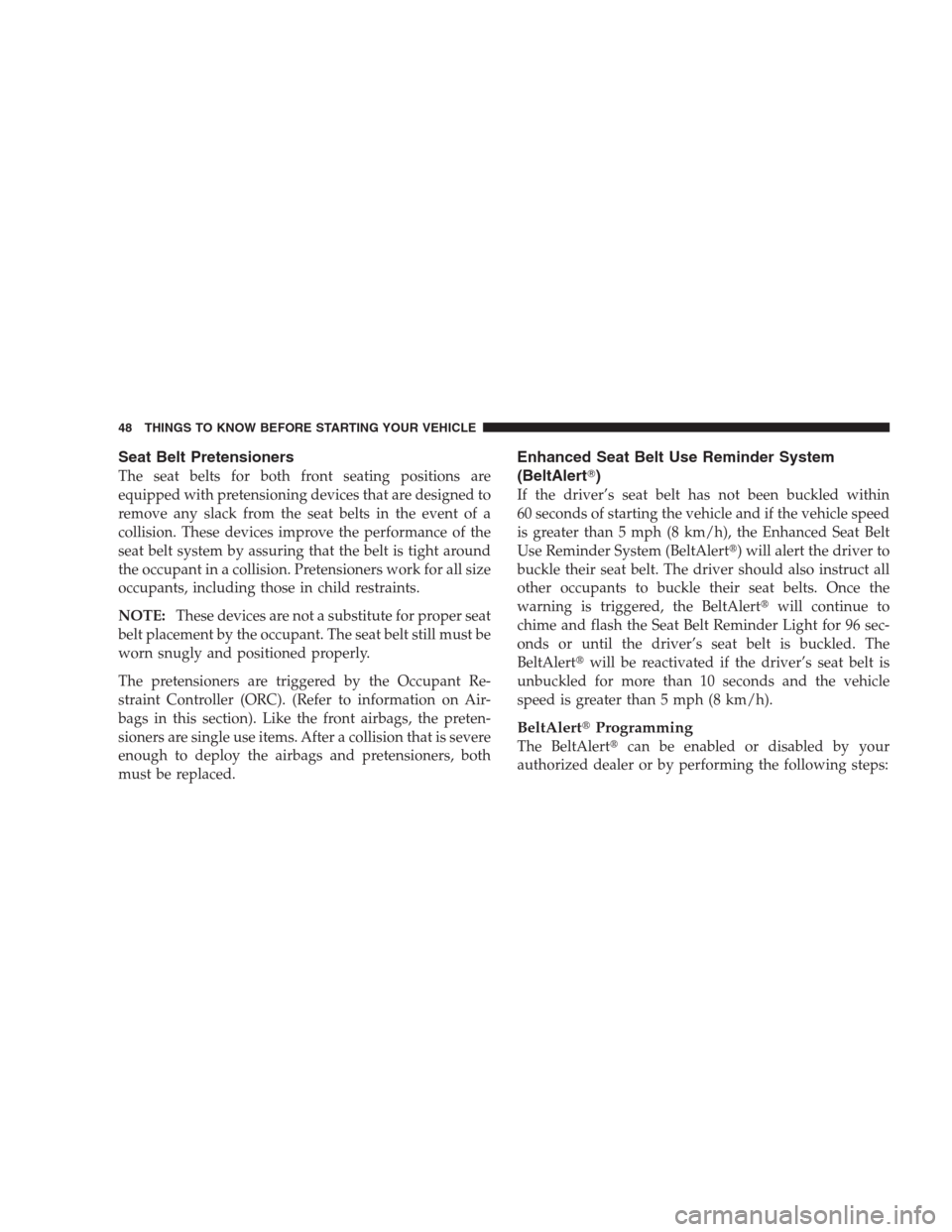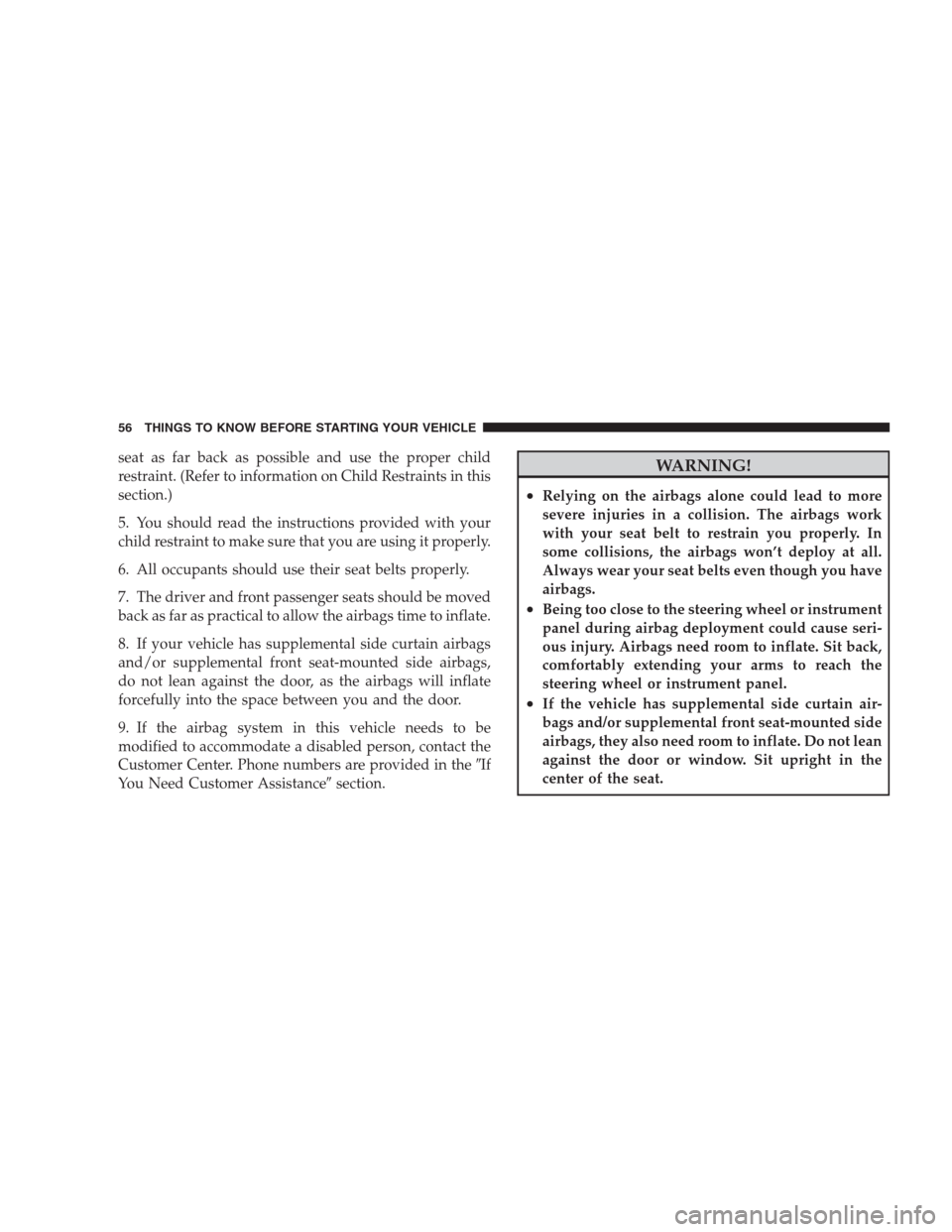Page 50 of 526

Seat Belt Pretensioners
The seat belts for both front seating positions are
equipped with pretensioning devices that are designed to
remove any slack from the seat belts in the event of a
collision. These devices improve the performance of the
seat belt system by assuring that the belt is tight around
the occupant in a collision. Pretensioners work for all size
occupants, including those in child restraints.
NOTE:These devices are not a substitute for proper seat
belt placement by the occupant. The seat belt still must be
worn snugly and positioned properly.
The pretensioners are triggered by the Occupant Re-
straint Controller (ORC). (Refer to information on Air-
bags in this section). Like the front airbags, the preten-
sioners are single use items. After a collision that is severe
enough to deploy the airbags and pretensioners, both
must be replaced.
Enhanced Seat Belt Use Reminder System
(BeltAlert�)
If the driver’s seat belt has not been buckled within
60 seconds of starting the vehicle and if the vehicle speed
is greater than 5 mph (8 km/h), the Enhanced Seat Belt
Use Reminder System (BeltAlert�) will alert the driver to
buckle their seat belt. The driver should also instruct all
other occupants to buckle their seat belts. Once the
warning is triggered, the BeltAlert�will continue to
chime and flash the Seat Belt Reminder Light for 96 sec-
onds or until the driver’s seat belt is buckled. The
BeltAlert�will be reactivated if the driver’s seat belt is
unbuckled for more than 10 seconds and the vehicle
speed is greater than 5 mph (8 km/h).
BeltAlert�Programming
The BeltAlert�can be enabled or disabled by your
authorized dealer or by performing the following steps:
48 THINGS TO KNOW BEFORE STARTING YOUR VEHICLE
Page 58 of 526

seat as far back as possible and use the proper child
restraint. (Refer to information on Child Restraints in this
section.)
5. You should read the instructions provided with your
child restraint to make sure that you are using it properly.
6. All occupants should use their seat belts properly.
7. The driver and front passenger seats should be moved
back as far as practical to allow the airbags time to inflate.
8. If your vehicle has supplemental side curtain airbags
and/or supplemental front seat-mounted side airbags,
do not lean against the door, as the airbags will inflate
forcefully into the space between you and the door.
9. If the airbag system in this vehicle needs to be
modified to accommodate a disabled person, contact the
Customer Center. Phone numbers are provided in the�If
You Need Customer Assistance�section.WARNING!
•Relying on the airbags alone could lead to more
severe injuries in a collision. The airbags work
with your seat belt to restrain you properly. In
some collisions, the airbags won’t deploy at all.
Always wear your seat belts even though you have
airbags.
•Being too close to the steering wheel or instrument
panel during airbag deployment could cause seri-
ous injury. Airbags need room to inflate. Sit back,
comfortably extending your arms to reach the
steering wheel or instrument panel.
•If the vehicle has supplemental side curtain air-
bags and/or supplemental front seat-mounted side
airbags, they also need room to inflate. Do not lean
against the door or window. Sit upright in the
center of the seat.
56 THINGS TO KNOW BEFORE STARTING YOUR VEHICLE
Page 67 of 526

1. Used for research purposes, such as to match data
with a particular crash record in an aggregate database,
provided confidentiality of personal data is thereafter
preserved.
2. Used in defense of litigation involving a Chrysler LLC
product.
3. Requested by police under a legal warrant.
4. Otherwise required by law.
Data parameters that may be recorded:
•Diagnostic trouble code(s) and warning light status for
electronically-controlled safety systems, including the
airbag system
•Airbag disable light status (if equipped)
•�Time�of airbag deployment (in terms of ignition
cycles and vehicle mileage)
•Airbag deployment level (if applicable)
•Impact acceleration and angle
•Seat belt status
•Brake status (service and parking brakes)
•Accelerator status (including vehicle speed)
•Engine control status (including engine speed)
•Transmission gear selection
•Cruise control status
•Traction/stability control status
•Tire Pressure Monitoring System status
Child Restraints
Everyone in your vehicle needs to be buckled up all the
time, including babies and children. Every state in the
United States and all Canadian provinces require that
THINGS TO KNOW BEFORE STARTING YOUR VEHICLE 65
2